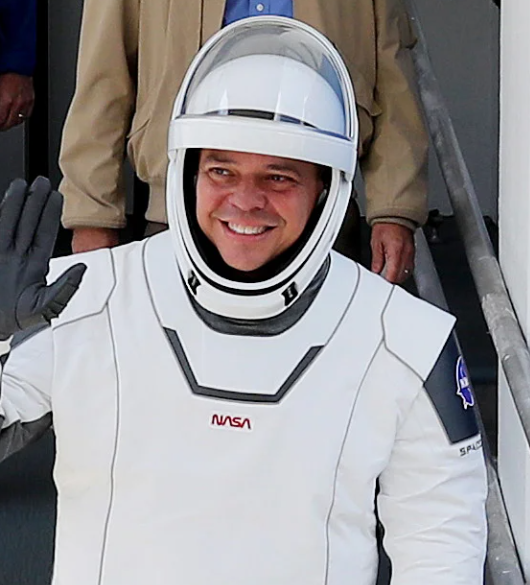Watch SpaceX and NASA Launch Two Astronauts to the ISS

ON SATURDAY AFTERNOON, veteran NASA astronauts Bob Behnken and Doug Hurley are expected to catch a ride to the International Space Station aboard SpaceX’s Crew Dragon. It’s a huge moment for space exploration and it marks the beginning of commercially operated crewed rocket launches. NASA and SpaceX have been working toward this goal for over a decade and this launch is the last major test before NASA certifies the Crew Dragon for human spaceflight.
Behnken and Hurley will depart from historic launch pad 39-A at NASA’s Kennedy Space Center in Florida. This is the same pad that sent the Apollo 11 astronauts on their way to the moon and also hosted the final space shuttle flight in 2011. That was the last time American astronauts launched from the US; since then, every astronaut bound from the US has hitched a ride on a Russian Soyuz rocket. Now, the nine-year hiatus on human spaceflight in America is coming to a close.
“It’s happening later than a lot of people were hoping, but it was as fast as humanly possible,” says Chad Anderson, the CEO of SpaceAngels, a space-focused venture capital firm that has invested in SpaceX. “They were competing with Boeing to be the first to deliver astronauts to the space station and they’re way out in front.”
During the shuttle era, Kennedy Space Center was usually packed with people who turned out to watch crewed launches. But NASA administrator Jim Bridenstine has urged would-be spectators to stay home and watch online to protect NASA employees from Covid-19. “We’re asking people not to come to Kennedy,” Bridenstine told reporters earlier this month. “It makes me sad to even say it, but we don’t want an outbreak.”
Behnken and Hurley have been in quarantine since May 13. A two-week quarantine is typical before launches to the International Space Station, but NASA and SpaceX took some extra precautions to ensure that the crew doesn’t bring the novel coronavirus to space. This mostly involved maintaining social distancing practices during training, keeping training personnel to a bare minimum, and requiring anyone interacting with the crew to undergo a temperature check and wear protective gear.
On Saturday, Behnken and Hurley headed to the pad about 3 hours before launch. They’ll be transported in a white Tesla Model X that is decked out in the old NASA “worm” logo that has been revived for the launch. They’ll take an elevator to the crew access arm on the launch tower and climb into the capsule. Behnken and Hurley will then do a series of system checks that will determine whether the capsule is go for launch, and they’ll arm the Crew Dragon’s abort system that will blast them off the pad if there’s an emergency. SpaceX will begin fueling the rocket with supercooled liquid oxygen and kerosene 45 minutes before launch.
Most Popular
Falcon 9 launching
SCIENCE
SpaceX Launched Two Astronauts—Changing Spaceflight Forever
DANIEL OBERHAUS
propella ebike
GEAR
The Propella 7-Speed Is the Budget Electric Bike to Get
PARKER HALL
A collage of phone book pages and an image of Edward Snowden
BACKCHANNEL
Inside the NSA’s Secret Tool for Mapping Your Social Network
BARTON GELLMAN
The vault of the Shrine of the Book building
SCIENCE
Turns Out 4 ‘Blank’ Dead Sea Scrolls Actually Have Text
JENNIFER OUELLETTE, ARS TECHNICA
ADVERTISEMENT
Once Behnken and Hurley are in space, it will take about 19 hours for the Crew Dragon to catch up with the space station. During that time, the astronauts will be testing out the capsule’s systems to collect data so NASA can later certify the spacecraft is safe for humans. The capsule is designed to fly without any human intervention, but it comes with backup manual controls that Behnken and Hurley will test out as they approach the station.
On April 27 2015 from Cape Canaveral Florida the SpaceX’s Falcon 9 rocket lifts off carrying Thales Alenia Space’s…
The Space X Falcon 9 rocket heads for space after lifting off from Pad 40 in Cape Canaveral Florida on June 4 2010.
The SpaceX’s Dragon spacecraft perched atop a Falcon 9 rocket lifts off from Pad 40 of the Cape Canaveral Air Force…
The SpaceX Falcon 9 Dragon on October 7 2012. They are being prepared for an evening launch from Cape Canaveral Florida…
SpaceX completes the first key flight test of its Crew Dragon spacecraft on May 6 2015 in Cape Canaveral Florida.
SpaceX’s Falcon 9 rocket stands after making its first successful upright landing on the Of Course I Still Love You…
The SpaceX Falcon 9 rocket with the Dragon spacecraft onboard launches from pad 39A at NASA’s Kennedy Space Center in…
The SpaceX Falcon Heavy launches from Pad 39A at the Kennedy Space Center in Florida on February 6 2018. It was carrying…
SpaceX Falcon 9 rocket curves around the Earth and into space after launching from Vandenberg Air Force Base on October…
A SpaceX Falcon 9 rocket with the company’s Crew Dragon spacecraft onboard sits on the pad before its launch to the ISS…
1 / 10
PHOTOGRAPH: NASA/GETTY IMAGES
On April 27, 2015, from Cape Canaveral, Florida, the SpaceX’s Falcon 9 rocket lifts off carrying Thales Alenia Space’s TurkmenÄlem52E/MonacoSat satellite to a geosynchronous transfer orbit.
Hurley, who was the pilot on the final shuttle mission, said the evolution of control systems in spacecraft mirrors the way control systems have changed in aircraft. “The shuttle had a fair amount of manual capability because the automation was not nearly as reliable at the time the system was designed,” Hurley told WIRED earlier this month. “In modern airliners, pilots are system managers and do very little hand flying, and it’s very much the same with Dragon. The commander and pilot are monitoring the vehicle’s trajectory and systems and don’t have to concentrate fully on actually flying.”
When Hurley and his crew flew on the last shuttle mission in 2011, they carried a flag to the space station. He left it there with instructions that no one should bring it back to Earth until the next time a crewed rocket launched from Florida. When Behnken and Hurley arrive at the station, they will “capture the flag” and bring it back home. But it might take them as long as three and a half months; NASA won’t decide how long the astronauts will stay on the station until they arrive.
The launch is scheduled for 3:22 pm EDT. It’s an instantaneous launch window, so if SpaceX can’t launch exactly on time, it will be pushed back to another day. NASA has a long list of weather criteria that must be met, which includes calm seas downrange from the launch pad. That means that weather not only has to be good in Florida, but across the Atlantic as well. “I’d expect a very high chance of scrubbing the launch due to weather,” Benji Reed, SpaceX’s director of crew mission management, told reporters earlier this month. The backup launch date is scheduled for Saturday, May 30. SpaceX did not respond to additional requests for comment.
The launch will be broadcast live by NASA and SpaceX. The agency has not provided a back update if the launch gets scrubbed on Saturday, but WIRED will update this post with more information when it’s available.
Update: On Wednesday, the launch was scrubbed at 17 minutes before liftoff due to bad weather conditions. The backup launch date is Saturday, May 30 at 3:22 pm.



 Creators of mankind
Creators of mankind Description of “Tall white aliens”
Description of “Tall white aliens” Where they came from?
Where they came from? About hostile civilizations
About hostile civilizations The war for the Earth
The war for the Earth “Tall white aliens” about eternal life
“Tall white aliens” about eternal life Video: “Nordic aliens”
Video: “Nordic aliens” Aliens
Aliens Alien encounters
Alien encounters The aliens base
The aliens base UFO
UFO Technology UFO
Technology UFO Underground civilization
Underground civilization Ancient alien artifacts
Ancient alien artifacts Military and UFO
Military and UFO Mysteries and hypotheses
Mysteries and hypotheses Scientific facts
Scientific facts


















